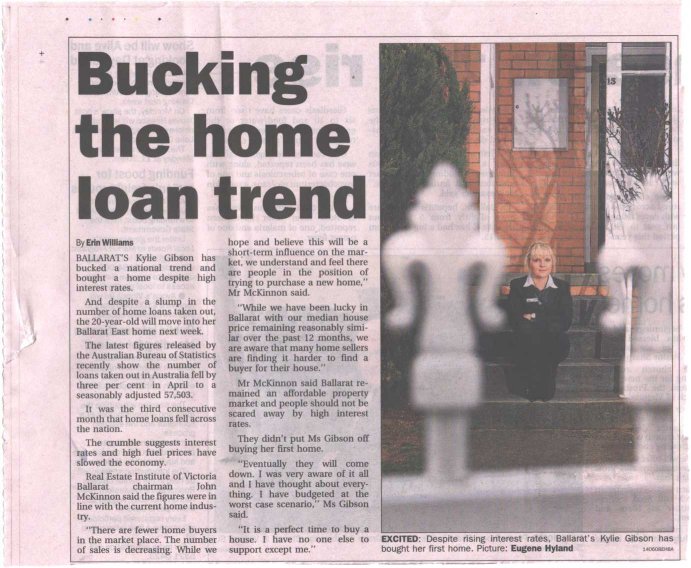I have previously spoken about my annoyance with the liberties available to the Real Estate industry because their agents are do not have to conform with the Australian Financial Services Licencing Act. I find this a bizarre legal exception, most especially because the housing market represents $4 trillion of national wealth versus $1.2 trillion in shares and roughly $1.2 trillion in various forms of deposits.
So while your local bank teller has to provide prudent financial disclosure for simply trying to inform you that you might be better off with a 6.5% term deposit over your standard bank account, your local real estate agent can spruik to his or her hearts content about the virtues of the “never declining” housing market with impunity. The REIA website proudly declares its members exemptions to the AFSL:
Under the Commonwealth’s Financial Services Reform Act (FSRA) 2001, all companies or individuals that provide a financial service must either hold an Australian Financial Services License (AFSL), become authorised by an AFSL holder or qualify for specific ‘relief’ from the regime under an ASIC determination.
The FSRA does not apply to real estate agents in their capacity selling individual real property. It does however include financial services provided in relation to products such as general insurance and managed investment schemes.
Real estate is a sales business so I understand that some “flexibility” with the facts is justifiable. However, after just a few days training, agents can take so many liberties with the largest financial transaction the average Australian will ever make it leaves me incredulous.
But it gets worse, because in many cases it isn’t just the Real Estate Industry providing the “flexibility” in the facts.
It is well known that the print media and the real estate industry have financial partnerships; you wouldn’t get real estate lift-outs that are half the size of the Saturday paper if it wasn’t the case. I have no issue with this relationship per se, as long as it is clearly declared by the media outlets and their agents when they are producing content on behalf of the real estate industry. The problem is in many cases it is not. No doubt it is often simply sloppy reporting, but the occurrence is so widespread that it is difficult to not also conclude that some systemic corruption of standards is underway. Either way, it is a disgrace to both industries and an utter embarrassment to regulators for providing a legal framework that allows it to occur.
Following are a very few examples of what I am talking about:
June 14 2008, The Courier – Bucking the home loan trend

Same newspaper different page.

Feb 04 2009 The Australian – Mum ready to go shopping for second home
The memory of her mortgage rate rocketing above 9 per cent last year is not enough to scare Kirsten Friedli away from the property game.
Following the Reserve Bank’s decision yesterday to drop the cash rate 100 basis points to a 45-year-low of 3.25 per cent, Ms Friedli is ready to go shopping for her second home.
Kirsten Friedli works for Dougmal Real estate and has done for 14 years, it is never declared in the article.
Feb 05 2009 – Daily Telegraph – Increased grant ‘the difference’
Last October, Ms Chenery and her boyfriend Graham Burden had been shopping for a house in the Camden area. Then came the initial incentive to combat the economic crisis – the increase to the first home buyers grant. With $24,000 suddenly on offer for building – up from $7000 – the couple switched to searching for affordable land. Last month they bought a lot in Camden’s Spring Farm estate – one of 17 first-home builders to do so in January.
Emma Chenery worked at Prudential Real estate, it was never declared in the article.
Feb 05 2011 Courier Mail – First home buyers slowly returning to Queensland property market after historical low
Ben Markwell, 23, and Elizabeth Brier-Mills, 22, were among those to buy for the first time at the end of last year.
Mr Markwell said they decided to buy a home at Collingwood Park when they discovered it would not cost much more than renting.
He said the first home buyer’s grant was a great incentive to people their age.
“I think people now in their early 20s are quite interested in property. They are interested in getting their first home,” Mr Markwell said.
At the time of the article Ben Markwell was a property agent for Century 21. It was never declared in the article.
Feb 12 2011 Adelaide Now – Making the first home a reality
Lisa Vallely, who bought a block of land late last year at Northgate to build her first home, says the great Australian dream is still achievable.
“You just have to look at what you can afford and prepare for the worst when budgeting for interest rates,” she says.
Lisa Vallely is an agent at Harcourts, it is never declared in the article.
As you can see these non-disclosed conflicts of interest have been happening for many years in the Australian print media. I am aware of many other examples. It seems to be a disease that is slowly creeping across the editor’s desk of many media outlets and is an insidious abuse of power by the print media and a huge failing of journalistic integrity. Given the limited regulations governing the real estate industry I am doubtful this sort of behaviour is illegal in any regard, but it is without a doubt immoral and misleading. I am sure if a stock broker tried a similar stunt the ACCC would be most interested.
You expect this sort of thing from local publications which are widely known to do combined editorial and advertising deals. But you’d hope that any large “respected” newspaper would stop this sort of thing at the door.
Yet, in my opinion, none of the examples above come close to an article in yesterday’s Australian.
For Brisbane potential home buyer Laura Kavanagh the low prices have provided a great opportunity.
She and partner Joe Bishop are looking for a property in Brisbane’s inner south in which they intend to live for a few years and then “trade up”. “We’re getting into the market now basically because we can,” she said.
“We can afford it at this stage, and hopefully prices will rise in the next few years.” Ms Kavanagh and other buyers said that the doubts over future levels of interest rates were not really a big factor in their decision to to enter the market.
“I don’t think they will go up, but even if they did it’s still a good time to get into the market,” she said.
Damien Hackett, chief executive of Place Estate Agents, which handles property on Brisbane’s southside, said the market was in a similar situation to the early 1990s. “The Brisbane market is generally behind Sydney and Melbourne, and I expect history to repeat itself and as those markets are going up then Brisbane probably will as well,” he said.
Laura Kavanagh is not only an undeclared real estate agent who happens to work for the same organisation as Damien Hackett , but she is actually offering unsolicited real estate advice under the guise of being an independent first home buyer. This is extraordinary contempt for the public by the agents and an utter embarrassment for The Australian newspaper.
For the most part, real estate is governed by State departments of fair trading or by the hopelessly compromised real estate institutes. Given the level of corruption, the size and importance of the market, as well as the degree of vested interest in the papers, something has to change. I suggest a new, publicly funded and dedicated authority such as ASIC should assume regulatory responsibilities. At the very least, new offices of real estate Ombudsman should be established to hold misleading conduct to account. I’m open to other suggestions.
Hat tip to Dan and crew at Bubblepedia for providing information for this post.
